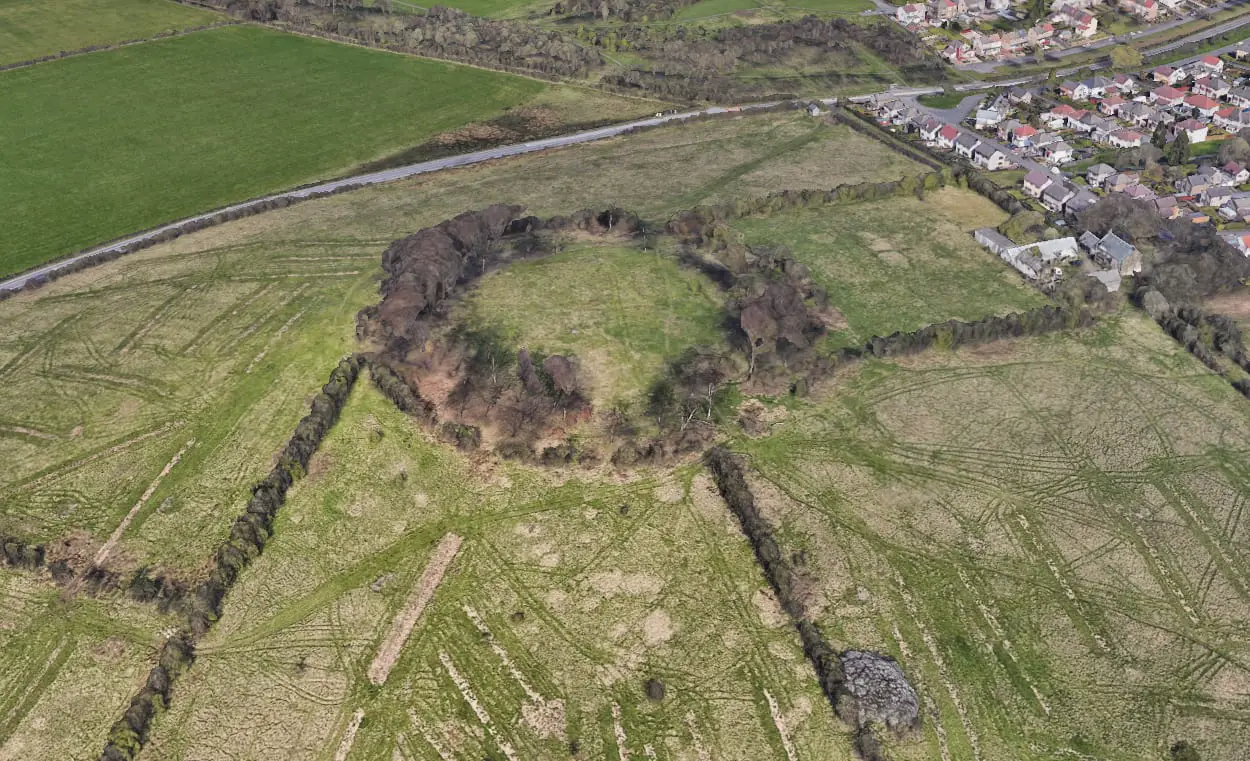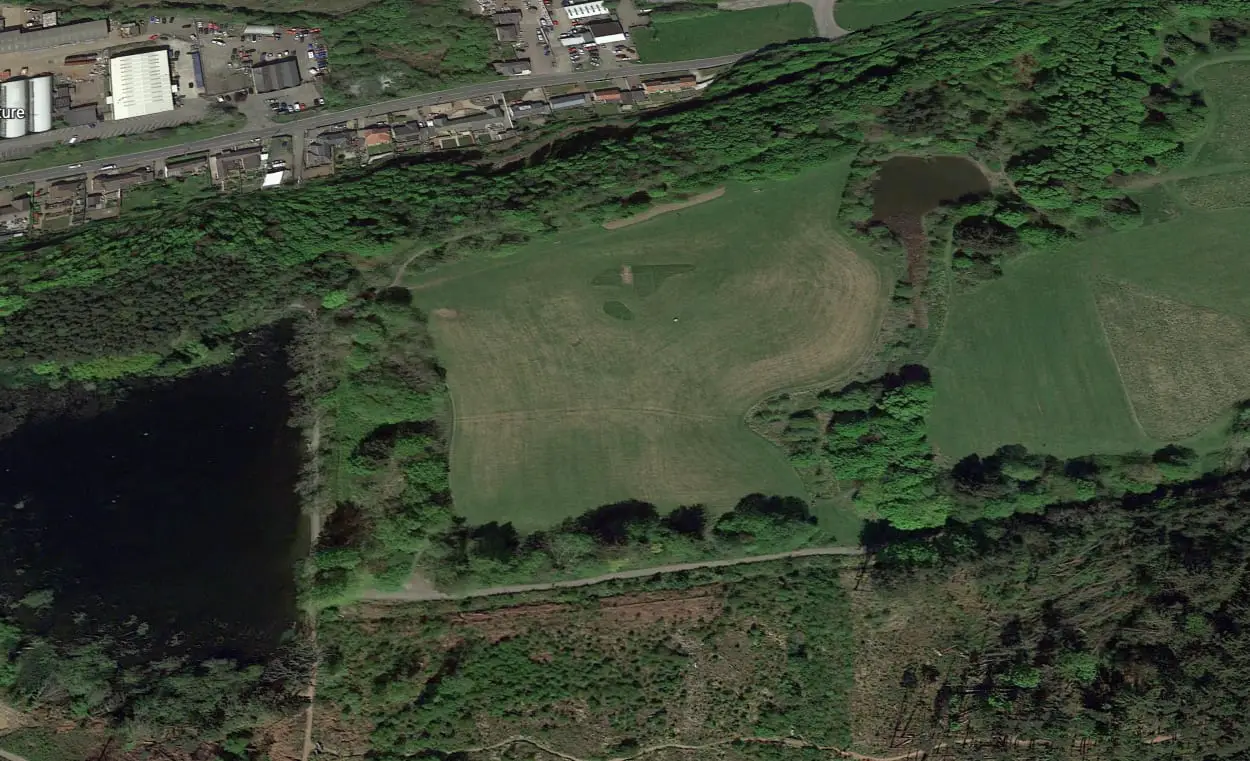The Antonine Wall (Vallum Antonini) was a defensive wall built by the Romans in present-day Scotland, that ran for 39 miles between the Firth of Forth, and the Firth of Clyde (west of Edinburgh along the central belt).
Construction began during the reign of Emperor Antoninus Pius in AD 142, in Caledonian territories previously held by the Damnonii, Otadini, Novantae, and the Selgovae tribes. The wall was intended to extend dominion over lands conquered by Governor Quintus Lollius Urbicus, cementing a new frontier 100 miles north of Hadrian’s Wall.
According to accounts in the Historia Augusta, Emperor Antoninus Pius “defeated the Britons through the agency of the legate Lollius Urbicus.” Urbicus then used the fortress at Coria as a base for campaigning in the northern tribal lands.
There are no surviving accounts documenting Urbicus’s campaign, but inscriptions at the Antonine Wall suggests that three legions were involved (supported by auxiliary units), including the Legio II Augusta based at Caerleon, the Sixth Victrix based at York, and the Twentieth Valeria Victrix based at Chester (which are credited with the walls construction).
Unlike the stone construction of Hadrian’s Wall, the Antonine Wall was built of turf on a stone foundation, reaching heights of around four metres, and was supported by a chain of 19 forts spread out every two miles. In addition to the main wall defences, the Romans built a number of coastal forts that probably functioned as supply bases, in addition to several forts from the redundant Gask Ridge line first built sometime between AD 70 and 80. After only eight years since the wall’s completion, the Roman’s abandoned the Antonine Wall and forts, choosing to withdraw to Hadrian’s Wall in AD 162.
In AD 208, Emperor Lucius Septimius Severus travelled to Britannia with an army of over 40,000 soldiers, intent on conquering all of Caledonia. He set about strengthening Hadrian’s Wall, and re-occupied the Antonine Wall with a garrison to ensure a strong position for campaigning north that retraced the steps of Agricola over a century before.
Some classical texts suggest Severus built another wall, named the Wall of Severus, however, scholarly consensus believes they are most likely referring to the Antonine Wall, with Hadrian’s Wall and Offa’s Dyke also being possible candidates.
An account of Severus’ campaigns into Caledonia, by the Roman chronicler Lucius Cassius Dio reads:
“Severus, accordingly, desiring to subjugate the whole of it, invaded Caledonia. But as he advanced through the country he experienced countless hardships in cutting down the forests, levelling the heights, filling up the swamps, and bridging the rivers; but he fought no battle and beheld no enemy in battle array.”
Further adding “Having thus been conveyed through practically the whole of the hostile country (for he [Severus] actually was conveyed in a covered litter most of the way, on account of his infirmity), he returned to the friendly portion, after he had forced the Britons to come to terms, on the condition that they should abandon a large part of their territory.”
Severus’ campaign was cut short when he fell ill and withdrew to Eboracum (York), where he died in AD 211. His son, Caracalla continued campaigning the following year, but soon settled for peace with the Caledonian tribes and withdrew his forces to Hadrian’s Wall, abandoning the Antonine Wall and the Roman’s ambition for conquest of Caledonia.
The Forts of the Antonine Wall (West to East)
Old Kilpatrick Roman Fort
The western edge of the Antonine Wall was marked by a square shaped fort at Old Kilpatrick, built by auxiliary regiments in AD 81 (preceding the Antonine Wall). The fort covered an area of four acres and contained a principia (headquarters), barracks and a granary, enclosed by an outer defensive wall. Old Kilpatrick was garrisoned by the First Cohort of Baetasians (cohors I Baetasiorum quingenaria peditata civium Romanorum ob virtutem et fidem), an auxiliary infantry unit of 500 men, originating from present-day Netherlands.

Duntocher Roman Fort
Duntocher is a small fort, built near the site of an earlier fortlet that predated the construction of the Antonine Wall. The fort was irregularly shaped, covering an area of ½ acre, with the earlier fortlet serving as a small military enclosure. The fort contained a central stone building, two sets of barracks, a large external annex, and a bathhouse located outside the defensive perimeter.

Cleddans Roman Fortlet
Cleddans is a small fortlet, previously built as a freestanding structure that was incorporated into the Antonine Wall defences. Little is known about the internal layout, but archaeologists assume that the fortlet most likely contained wooden structures, presumably barracks.

Castlehill Roman Fort
Castlehill is a fort built on the western edge of Bearsden that covered an area of 3.5 acres. The fort was garrisoned by a mixed infantry and cavalry regiment, consisting of 500 soldiers from the Cohors quarta Gallorum equitata (“4th part-mounted Cohort of Gauls”).

Bearsden Roman Fort
Bearsden is a fort in the present-day town of Bearsden. The fort covered an area of 2.5 acres, with the only physical remains being a bathhouse and latrine block located in the area of the fort’s annexe. Inscriptions discovered at Bearsden associate the fort with the Twentieth Victorious Valerian Legion (legio XX Valeria victrix), one of the four legions involved in the invasion of Britain by Emperor Claudius in AD 43.

Summerston Roman Fortlet
Summerston is the site of a small fortlet and early marching camp, located in the present-day suburbs of Glasgow. Archaeologists propose that the site was the base for building crews from the Second Legion during the construction of the Antonine Wall.

Balmuildy Roman Fort
Balmuildy was a fort and castrum, built between AD 142 and 154 by the Second Legion on the outskirts of present-day Glasgow. The fort was one of only two forts on the Antonine Wall which had stone ramparts, and contained a principia, granaries, barracks, workshops, and a bathhouse.

Wilderness Plantation Roman Fortlet
Wilderness Plantation is a small fortlet, constructed to the north-west of Bishopbriggs and contained several timber buildings which archaeologists believe may have been barracks, lean-to structures and hearths.

Cadder Roman Fort
Cadder is the site of a fort which archaeologists suggest was constructed by the Second Legion on the northern side of present-day Bishopbriggs. The fort contained several stone structures, including a principia, granaries, bathhouses, and timber buildings that have been identified as barrack blocks.

Glasgow Bridge Fortlet
Glasgow Bridge is the site of a small fortlet made from turf and ramparts, located west of present-day Kirkintilloch. Archaeologists are yet to conduct excavations of the fortlet, but aerial photograph suggests that the site covers an area of 0.0049 acres.

Peel Park Roman Fort
The fort at Peel Park is located in present-day Kirkintilloch and dates from the mid-2nd century AD. Nothing of the fort is visible today, with the only identifiable earthworks dating from a 12th century Motte and Bailey castle constructed by the Clan Comyn.

Auchendavy Roman Fort
Auchendavy is a fort located on the outskirts of Kirkintilloch. Little visible remains of the fort survive, but aerial photography indicates that Auchendavy’s plan consisted of three parallel ditches, accompanied by raised ramparts. During the construction of the Forth and Clyde Canal, workers discovered a large number of stone balls from a giant catapult, as well several altars that suggests the fort was associated with either the 20th Legion Valiant, or the Second Augusta Legion.

Bar Hill Roman Fort
Barr Hill fort was built around AD 142 near the present-day village of Twechar. The fort is unique, in that it was constructed as a freestanding structure some 30 metres south of the Antonine Wall. The fort contained several stone structures, including a principia, granaries, bathhouses, and timber buildings. Items recovered in situ includes an altar, bones, shells, coins, and shoes.

Croy Hill Roman Fort
Croy Hill Roman Fort was constructed during the mid-2nd century AD, covering an area of around 1.2 acres on a levelled plateau on the Eastern side of the hill. The fort occupies the site of an earlier fortlet and temporary encampment, with the final phase containing a principia, granary, and bath-house.

Westerwood Roman Fort
Westerwood is the site of a Roman fort, located east of the present-day village of Castlecary. Very little evidence of the fort remains today, with only shallow earthworks of the southern defensive ditches being traceable. An altar discovered at Westerwood suggests the fort was garrisoned by a detachment of the 6th Legion.

Castlecary Roman Fort
Castlecary is the site of a large Roman fort, first built around AD 80 during the campaigns by Agricola into Caledonia. With the construction of the Antonine Wall, the fort was expanded by the Second Legion and the First Cohort of Tungrians, to include a stone rampart, a principia, commanders house, barracks, bath house, and an external annexe.

Rough Castle Roman Fort
Rough Castle is the site of a small fort, in between present-day High Bonnybridge and Tamfourhill. The fort covered an area of 0.9 acres and contained several buildings made of stone, including a principia, commanders house, granary, barracks, and a bath house. Inscriptions from artifacts recovered in the fort suggest that it was garrisoned by 480 men of the Cohors VI Nerviorum of Nervii, foot soldiers drawn from a north-eastern Gallic tribe. A feature of the defences at the fort includes pits, known as lilia, which would originally have contained sharpened stakes at the bottom.

Watling Lodge Roman Fortlet
Watling Lodge is a small fortlet situated near an earlier Roman marching camp in the present-day district of Camelon in Falkirk. Little remains of the fortlet, but the site marks one of the best-preserved stretches of the Antonine Wall.

Falkirk Roman Fort
The fort in Falkirk is located in the town centre of present-day town of Falkirk. Virtually nothing survives above street level, with the fort only being recently identified by the ditches of either the fort or its annexe.

Mumrills Roman Fort
Mumrills was the site of the largest Roman fort on the Antonine Wall, covering an area of 6.5 acres. and overlapping an earlier adjacent Agricolan fort that formed the latter’s annex. The fort is located near the present-day village of Laurieston in the Falkirk area and contained a number of stone buildings, including a principia, commanders house, bathhouses, and timber buildings identified as barracks.

Inveravon Roman Fort
Inveravon was built on the site of two previous marching camps, located south of the present-day town of Grangemouth. Very little of the fort survives on the surface, but archaeologists have discovered the foundations of stone walls and cobbled surfaces, as well as ‘expansions’ which may have been signal or beacon towers.

Kinneil Roman Fortlet
Kinneil is the site of a small Roman fortlet, located in the grounds of the historic Kinneil House near Bo’ness. The fortlet is marked out by original stone kerbing of its ramparts and part of the rampart of the Antonine Wall.

Carriden Roman Fort
Carriden is the most easterly fort directly associated with the Antonine Wall and is the only Antonine Fort whose Latin name “Veluniate” is known. The site also provides the only clear evidence for an associated vicus, identified by an altar which gives mention of the vikini (villagers or vicus dwellers).

Header Image Credit (adapted) – PaulT (Gunther Tschuch) – CC-BY-4.0





